Department of Education of the Administration of the Urban District Sukhoi Log Municipal Autonomous Educational Institution "Secondary School No. 5"
Features of the nature of Central Siberia
Executor: teacher of geography Listratova O.I.
Sukhoi Log 2016
Significant amplitudes of heights and a highly rugged relief determine a clearly pronounced altitudinal zoning, which is especially typical for the most elevated northern provinces of the country. So, in the mountains of the lower reaches of the Lower Tunguska at an altitude of up to 250-400 m there is a dark coniferous taiga, which is replaced higher by light coniferous larch forests. At an altitude of 500-700 m they pass into mountain sparse larch forests or thickets of bush alder; tops of massifs rising above 700-800 m occupied by mountainous rocky tundra.
The soils and vegetation of Central Siberia develop in a sharply continental, harsh climate. There is less precipitation here than in the more western regions of the USSR, the thickness of the snow cover is usually low, and permafrost is almost everywhere. In contrast to Western Siberia, soils are formed mainly on gravelly and loamy eluvium of bedrock; they are usually rocky and not very thick. There are few bogs, and they are found mainly within lowlands and on flat, poorly drained interfluves.
In the northern half of the Central Siberian taiga, gley-permafrost-taiga and permafrost-taiga soils are formed. Their main features are associated with the permafrost horizon lying close to the surface, which creates conditions for a non-washing water regime and impedes the removal of salts. Permafrost taiga soils are characterized by an acidic reaction and the presence of traces of movement of the soil mass under the influence of permafrost phenomena: bulging as a result of hydrodynamic stresses, sliding and floating. These processes contribute to the constant mixing of the material and cause a weak differentiation of the horizons of the soil profile. However, in its upper part, there is usually a thin horizon of coarse light humus, and below there are numerous traces of gleying - the result of periodic summer waterlogging experienced by the soil mass. On the loesslike loams of Central Yakutia, soddy-forest and permafrost-taiga pale yellow (neutral) solodized soils are formed, which have no analogues anywhere in the world.
Significant areas are also occupied by soils formed in mountainous terrain - mountain tundra (in the Byrranga, Putorana mountains and in the Anabar massif), mountain permafrost taiga and mountain forest carbonate. In the south - in the Angara region - zonal sod-podzolic and sod-forest brown ones dominate, and in the forest-steppe "islands" - gray forest soils and chernozems.
The vegetation cover of the taiga zone, which occupies more than 70% of the territory of Central Siberia, also has a peculiar character. It is dominated by light coniferous forests of Siberian larch (in the west) and Daurian (in the east). The dark coniferous taiga has been pushed back to the extreme western regions and to the elevated areas of the southern provinces. A warm and not very humid summer is the reason for a more significant than anywhere else, the advancement of forests to the north: in Taimyr, woody vegetation occurs at 72 ° 50 ′ N. NS.
The peculiarities of the continental climate are associated with the existence in the taiga, often even near the Arctic Circle, of steppe islands and areas of halophytic vegetation on salt marshes (Central Yakutsk lowland). Spring here lasts no more than three to four weeks; under the warm rays of the sun, the snow cover amicably melts, and vegetation develops with cinematic speed. That is why many vegetables and even watermelons ripen in the vicinity of Yakutsk during the short but hot summer; Central Siberia is one of the richest parts of the Soviet Union in various natural resources. However, due to the poor development of the territory, its wealth is still far from being fully utilized.
In the first place among the natural resources of the country are various minerals, the deposits of which are associated with the Precambrian, Paleozoic and Mesozoic rocks. In Central Siberia there are the largest coal basins, deposits of iron ores, non-ferrous metals, gold, graphite, diamonds, various raw materials for the chemical industry and the production of building materials. Mining is the most important branch of the economy of Central Siberia. (See Figure 10)
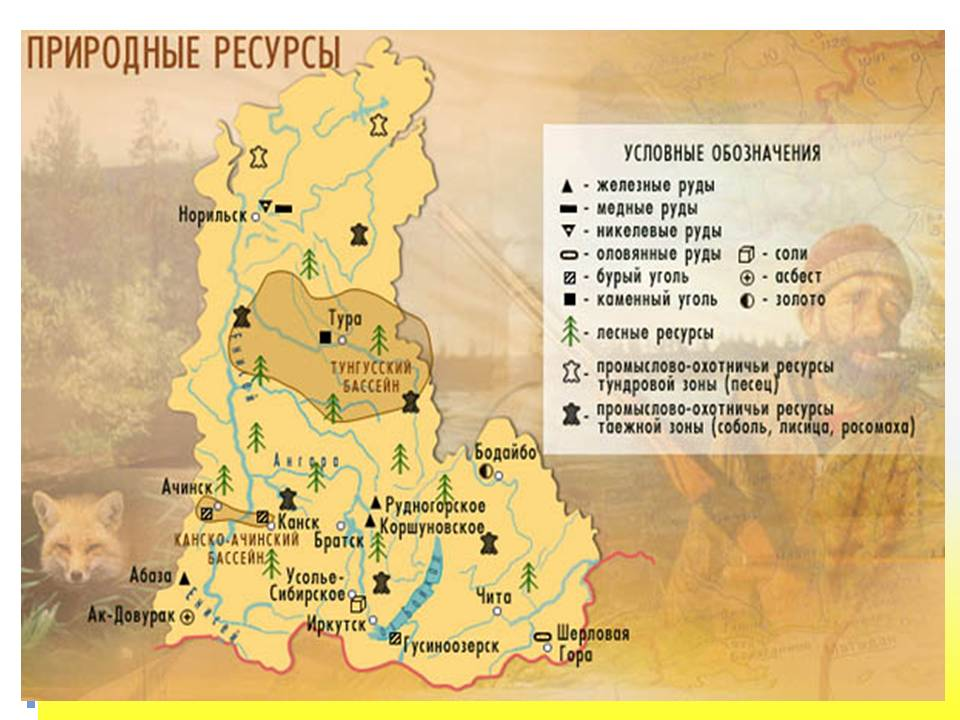
Fig. 10 Natural resources
The fauna of Central Siberia is richer and more diverse than the fauna of the West Siberian Plain. More mammals and birds live here; many of them are of great commercial value (squirrel, Siberian weasel, ermine, muskrat, arctic fox (see Appendix 10), etc.). Animals like musk deer appear(Moschus moschiferus) (see appendix 12), northern pika(Ochotona hyperborea) and bighorn sheep (Ovis nivicola) ; sable (see Appendix 9) and reindeer (see Appendix 11) are more common than in Western Siberia. In some taiga regions of Yakutia, lying even near the Arctic Circle, steppe animals such as the long-tailed ground squirrel ("evrazhka" - Citellus undulatus ) and black-capped marmot(Marmota camtschatica) ... Some southern birds also penetrate far to the north: bittern(Botaurus stellaris) , rock dove(Columba livia) , lark. There are also many taiga birds that are not typical for Western Siberia: the stone capercaillie(Tetrao urogalloides), black crow (Corvus corone orientalis) , killer whale and several passerine species. The diversity of the fauna of Central Siberia is associated with the relatively ancient age of the country and with the differences in its modern natural conditions.
Thus, the flora and fauna are greatly influenced by its specific severe, sharply continental climate and the almost ubiquitous permafrost associated with it. Permafrost preservation is favored by low average annual temperatures and the peculiarities of the cold period inherent in this climate: low temperatures, little cloudiness, contributing to night radiation. (see Figure 12).
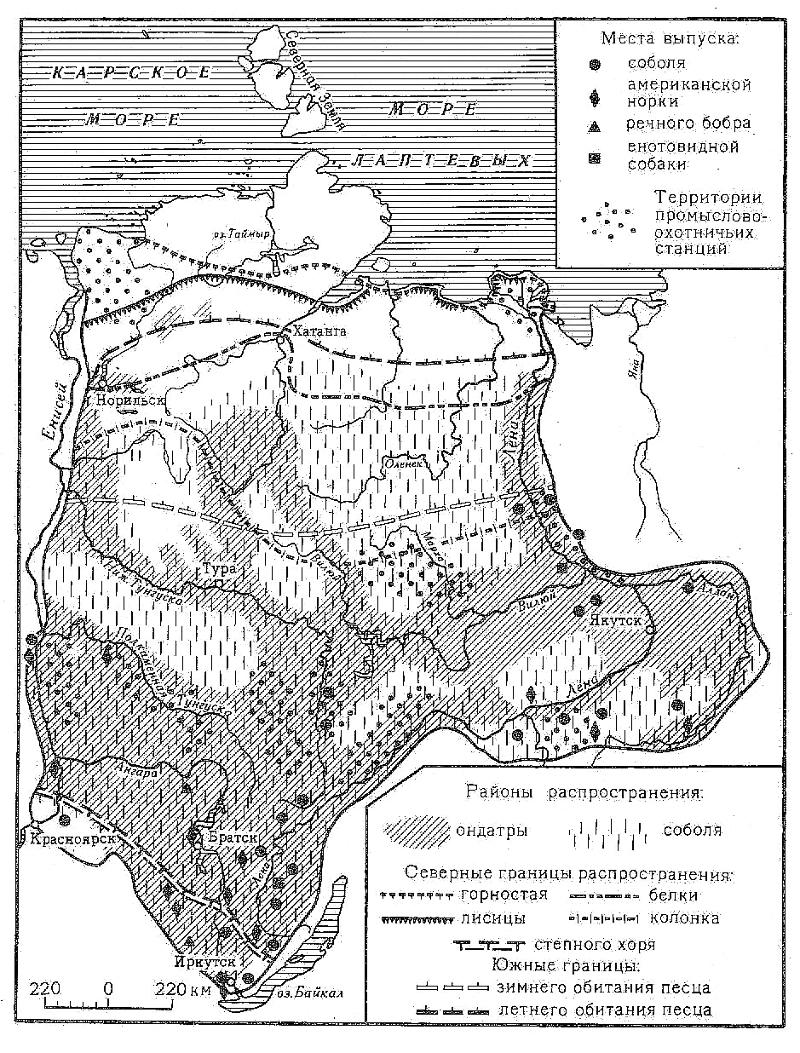
Rice. 12 Fauna of Central Siberia
Chapter 3. Ecological features of the nature of Central Siberia
3.1. Anthropogenic changes in nature
VXv - Xvicenturies in Central Siberia, small ethnic groups and tribes lived, scattered over a vast territory. Only the Yakuts, who inhabited the Leno-Vilyui (Central Yakutsk) plain and the adjacent river valleys, were engaged in cattle breeding (horse breeding), hunting and fishing, the rest - in hunting and fishing. Some tribes had deer.
After the annexation of the territory to Russia, the economic structure of the population does not essentially change, only the development of fur resources intensifies. Already at the beginning of the 18th century, 40% of the population lived in Pre-Sayan, and by the end of the 19th century - 80% of the population of Central Siberia. By the middle of the 18th century. here the Moscow (Siberian) highway was laid to the coast of the Pacific Ocean, and in 1893 - 1899. the railway is part of the Trans-Siberian Railway. This contributed to a further increase in population and the development of agriculture to meet the needs of the entire local population. The fur trade continues to develop throughout the rest of the territory.
From the middle of the XIX century. pockets of gold mining appear in the Yenisei Ridge, and in the last years of the century, when coal was needed in connection with the operation of the railway, its production began in the Cheremkhovsky basin. In Predsayanye and in some places near the Angara, logging begins. All this led to changes in nature in the southwestern, pre-Sayan, part of Central Siberia. In the rest of the territory, changes affected only the animal world. Due to excessive hunting, the main object of the fishery - sable in many places has disappeared almost completely. The number of squirrels has also significantly decreased.
The established direction of the economy in Central Siberia is preserved in the post-revolutionary years. At the same time, focal farming is advancing to more northern regions, the number of livestock is increasing, and the volume of logging in the Angara basin and in the upper reaches of the Lena is increasing. In Soviet times, new centers of industrial development of Central Siberia arose on the basis of the use of its mineral resources in the regions of Norilsk and Mirny. All this led to an increase in human impact on nature, but at the same time the local nature of the impact itself remained. Only an unintended effect on vegetation has covered large areas. This is due to the spread of forest fires, most often caused by humans. 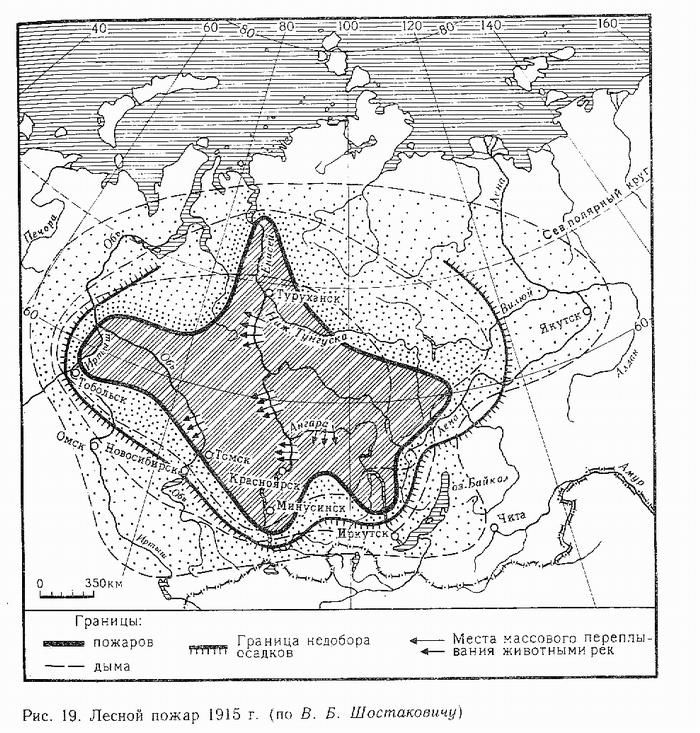
Rice. 13 Forest fire in 1915 (according to VB Shostakovich)
Fires sometimes engulfed vast areas. For example, the catastrophic fire of 1915 spread from the Sayan Mountains to the lower reaches of the Yenisei and from the Ob to the upper reaches of the Podkamennaya Tunguska. During this fire, about half of the forests in the Yenisei basin within Central Siberia were destroyed. (see fig. 13)
The economic basis for the development of the economy of Central Siberia at the present time is the approximation of industry to the sources of raw materials. But the development of natural resources in the harsh Siberian climate requires high costs and respect for nature in the process of exploiting its resources. In recent decades, more and more centers of local changes in nature have appeared in the course of mining, transport and energy construction.
Man actively invades nature and often changes the permafrost regime, which entails not only a change in the soil and vegetation cover, but often the relief. These changes are often irreversible, although they do not yet cover large areas. The main areas of human impact on nature are the Angara basin, the regions of Norilsk, Western Yakutia and the Central Yakutsk plain.
3.2. Economic and environmental prospects for the development of the territory of Central Siberia
On the map of the Irkutsk Region or Krasnoyarsk Territory, huge undeveloped massifs of the Siberian taiga are depicted, the abundance of monochrome green spaces, broken only by thin blue threads of rivers, is striking. Only the Sayan region can be considered inhabited, where the majority of the population lives and the main enterprises are concentrated. It is here that the seven main industrial centers of the region are located: Angarsk, Bratsk, Zima, Irkutsk, Krasnoyarsk, Cheremkhovo and Shelekhov. Unfortunately, all of them were included in the list of cities with the highest level of air pollution in Russia. Harmful wastes threaten human health and cause significant damage to forests and soils. The ecological problems of the region will become more and more acute with the further development of its enormous natural resources.
The economic basis for the development of the economy of Central Siberia is the approach of industry to the sources of raw materials. But the development of natural resources in the harsh Siberian climate of high costs and respect for nature in the process of exploiting its resources. In the last decade, more and more centers of local changes in nature have appeared in the course of mining in transport and energy construction.
Man actively invades nature and often changes the permafrost regime, which entails not only a change in the soil and vegetation cover, but often the relief. These changes turn out to be irreversible, although they do not yet cover large areas. The Angara basin is a striking representative of the areas of human impact on nature. To preserve unique and typical natural complexes, for the protection of animals in 1985 in the lower reaches of the Lena, the Ust-Lensky reserve was created on an area of about 1.5 million hectares, and in the Tunguska province - Central Siberian with an area of slightly less than 1 million hectares.
It is important to preserve and protect the Central Siberian taiga as much as possible, not only for ethical and moral reasons, as a unique habitat, but also because, apparently, the coniferous forest plays an essential role in the regulation of CO2 reserves in the Earth's atmosphere. This has become apparent as a result of recent research. Taiga regeneration is painfully slow. When soil layers are removed, permafrost rises to the surface and prevents new trees from growing. It is now obvious that it is the human impact that causes the most dramatic changes in the taiga ecosystem.
Large-scale mining of iron ore, gold and minerals has left an imprint on significant areas of the region. Roads, settlements and all infrastructure have completely changed the local environment. Moreover, steel mills and pulp and paper mills seriously pollute the air.
Impact factors include:
- deforestation;
- water and air pollution;
- Forest fires;
- roads, dams, hydroelectric power stations, pulp and paper mills, metallurgical plants, mining and so on.
Particularly valuable are the pine and pine-deciduous forests of the Angara basin, where over 35 million hectares are concentrated. Pine forests.
The forest is an important physical and geographical factor that creates a special climate, retains moisture, and weakens the wind speed. The overwhelming part of the territory of the Central Siberian Plateau belongs to forest-abundant regions.
Today, the anthropogenic pressure on the fauna of Central Siberia has increased many times, although today one can be proud of the world's leadership in the production of valuable fur animals, a lot of birds and river fish, then soon without the organization of cultural hunting and fishing and fish farms, without the creation of reserves and reserves, none of this will not.
Conclusion
The purpose of the course work: to identify the features of the nature of Central Siberia has been successfully achieved. The main components of nature have been characterized. We managed to study and analyze archival materials on this topic. The characteristic of the territory of Central Siberia is given, the features of its nature are revealed. The contribution of scientific researchers in the study and research of this territory is shown.
The work done made it possible to draw the following conclusions:
1.Central Siberia is a complex formation in terms of relief and history of formation. On its territory there are both plateaus and mountains with steep river valleys and narrow watershed ridges. So, the Putorana plateau is the highest part of the Central Siberian plateau.
2. The territory of Central Siberia is characterized by river valleys with well-defined terraces and numerous shallow valleys. The presence of terraces testifies to the slow movements of the earth's crust that took place on the territory of the plateau.
3. The climate is sharply continental. Permafrost is widespread. The formation of permafrost took place back in the Ice Age. Permafrost is a legacy of the Ice Age.
4. The Central Siberian region has a rich material and raw material base, sufficiently prepared for industrial development.
5. The water resources of the Central Siberian Plateau are one of the most valuable natural resources. Groundwater resources can be renewed in accordance with natural cycles characteristic of a particular climatic zone, geological structure and landscape features of the territory.
6. Physical and geographical conditions, the considerable length of the Central Siberian plateau, the complexity and dissection of the relief determine the diversity of natural zones. The natural zones, represented by forest-tundra and taiga, are integrated ecological complexes arising from the influence of plants and animals with the environment. Each of the zones is characterized by its own set of plant life forms and a specific dominant form.
These findings confirm that the nature of Central Siberia is unique.
Thus, this work can be used in the practical activities of teachers, students during teaching practice.
Bibliographic list
Rakovskaya E.M., Davydova M.I. Physical geography of Russia: Textbook. for stud. higher. study. institutions. - M .: Humanit. ed. center "Vlados", 2009
Okladnikov A.P. "Discovery of Siberia" 2014
V.P. Dronov, I.I. Barinov, V. Ya. Rom, A.A. Lozhbanidze “Geography of Russia. Economy and geographic areas ". Moscow "Bustard" 2010
Voskresensky S.S. Geomorphology of Siberia 1962
Golovachev P.Sh. "Economic Geography of Siberia" 2009
Paramuzin Yu.L. The secret of Siberia. M .: Thought, 1985.
Rakovskaya E.M., Davydov M.I. Physical geography of Russia. Textbook. For students of pedagogical higher educational institutions. Part 2.M .: VLADOS, 2001.
Great Soviet Encyclopedia. Volume 23.M .: Soviet Encyclopedia, 1976.
Mikhailov N.I., Gvozdetsky N.A. "Physical Geography of the USSR", 1987.
Prokaev V.I. "Physical and geographical zoning" Uch. A handbook for students Ped. Institutes for Geography. Ed. Enlightenment, 1983.
Popov A.I. Permafrost phenomena in the earth's crust. Ed. Moscow University 2005.
Central Siberia Ed. Moscow "Science", 2007
Babushkin V.A. "Workshop"
Geocryology of the USSR. Central Siberia 1989
Climatic conditions and microclimate of the taiga geosystems of Siberia. Novosibirsk: Science, 1980.
Tushinsky G.K., Davydova M.I., Physical Geography of the USSR. M .: "Education", 1976. https://ru.wikipedia.org
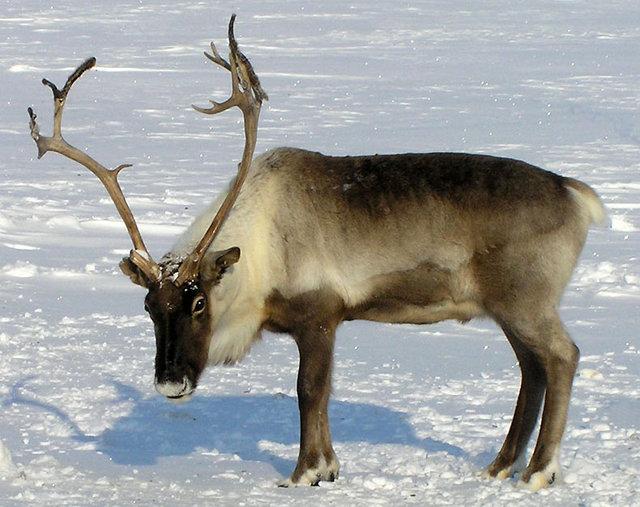
Appendix 11 Reindeer
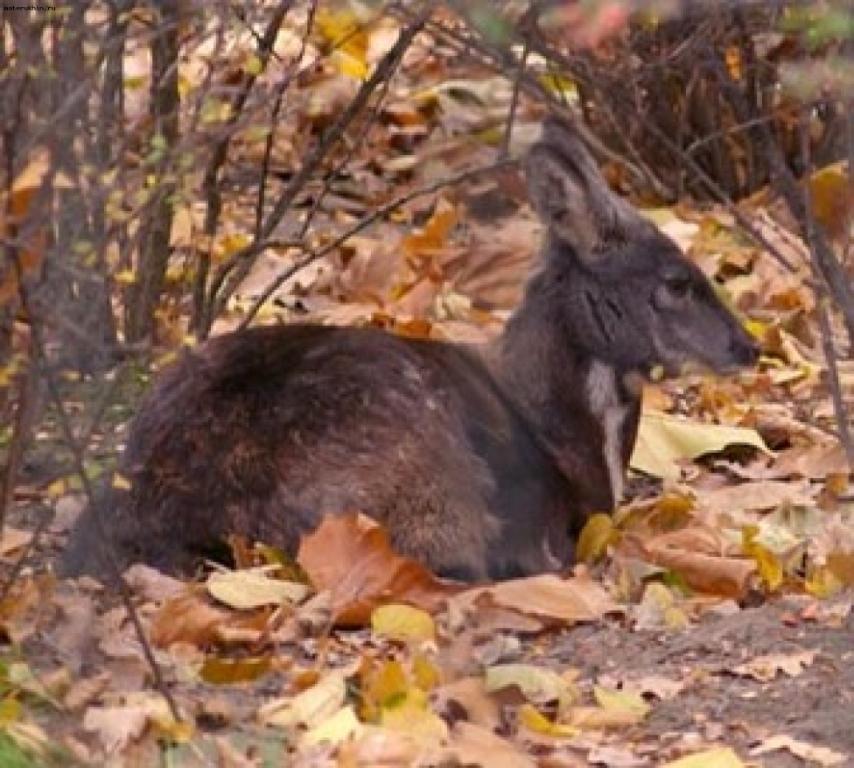
Appendix 12 Musk deer




